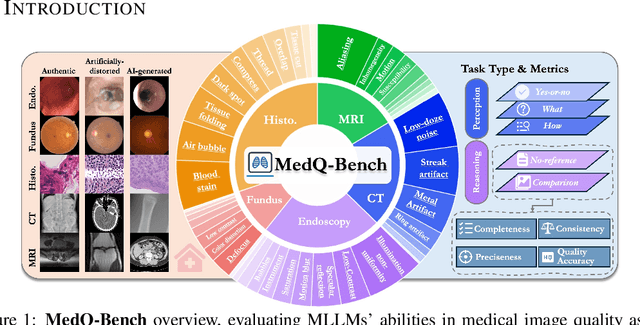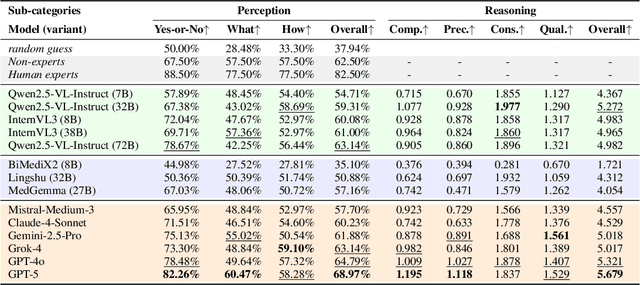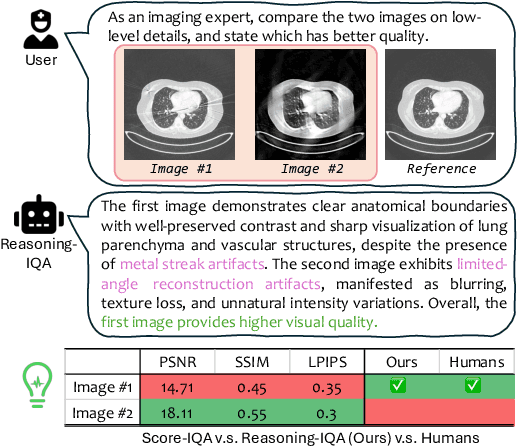Dingkang Yang
Beyond Pixel Simulation: Pathology Image Generation via Diagnostic Semantic Tokens and Prototype Control
Dec 24, 2025Abstract:In computational pathology, understanding and generation have evolved along disparate paths: advanced understanding models already exhibit diagnostic-level competence, whereas generative models largely simulate pixels. Progress remains hindered by three coupled factors: the scarcity of large, high-quality image-text corpora; the lack of precise, fine-grained semantic control, which forces reliance on non-semantic cues; and terminological heterogeneity, where diverse phrasings for the same diagnostic concept impede reliable text conditioning. We introduce UniPath, a semantics-driven pathology image generation framework that leverages mature diagnostic understanding to enable controllable generation. UniPath implements Multi-Stream Control: a Raw-Text stream; a High-Level Semantics stream that uses learnable queries to a frozen pathology MLLM to distill paraphrase-robust Diagnostic Semantic Tokens and to expand prompts into diagnosis-aware attribute bundles; and a Prototype stream that affords component-level morphological control via a prototype bank. On the data front, we curate a 2.65M image-text corpus and a finely annotated, high-quality 68K subset to alleviate data scarcity. For a comprehensive assessment, we establish a four-tier evaluation hierarchy tailored to pathology. Extensive experiments demonstrate UniPath's SOTA performance, including a Patho-FID of 80.9 (51% better than the second-best) and fine-grained semantic control achieving 98.7% of the real-image. The meticulously curated datasets, complete source code, and pre-trained model weights developed in this study will be made openly accessible to the public.
Forging a Dynamic Memory: Retrieval-Guided Continual Learning for Generalist Medical Foundation Models
Dec 15, 2025Abstract:Multimodal biomedical Vision-Language Models (VLMs) exhibit immense potential in the field of Continual Learning (CL). However, they confront a core dilemma: how to preserve fine-grained intra-modality features while bridging the significant domain gap across different modalities. To address this challenge, we propose a comprehensive framework. Leveraging our 18-million multimodal and comprehensive medical retrieval database derived from PubMed scientific papers, we pioneer the integration of Retrieval-Augmented Generation (RAG) into CL. Specifically, we employ a multi-modal, multi-layer RAG system that provides real-time guidance for model fine-tuning through dynamic, on-demand knowledge retrieval. Building upon this, we introduce a dynamic knowledge distillation framework. This framework precisely resolves the aforementioned core dilemma by dynamically modulating the importance of the parameter space, the granularity of the distilled knowledge, and the data distribution of the reference dataset in accordance with the required level of detail. To thoroughly validate the clinical value of our strategy, we have designed a more rigorous \textbf{M}edical Generalist Task Incremental Learning (MGTIL) benchmark. This benchmark is engineered to simultaneously evaluate the model's capacity for adaptation to significant domain shifts, retention of subtle intra-domain features, and real-time learning of novel and complex medical tasks. Extensive experimental results demonstrate that our proposed method achieves state-of-the-art (SOTA) performance across all metrics. The code is provided in the supplementary materials.
FysicsWorld: A Unified Full-Modality Benchmark for Any-to-Any Understanding, Generation, and Reasoning
Dec 14, 2025Abstract:Despite rapid progress in multimodal large language models (MLLMs) and emerging omni-modal architectures, current benchmarks remain limited in scope and integration, suffering from incomplete modality coverage, restricted interaction to text-centric outputs, and weak interdependence and complementarity among modalities. To bridge these gaps, we introduce FysicsWorld, the first unified full-modality benchmark that supports bidirectional input-output across image, video, audio, and text, enabling comprehensive any-to-any evaluation across understanding, generation, and reasoning. FysicsWorld encompasses 16 primary tasks and 3,268 curated samples, aggregated from over 40 high-quality sources and covering a rich set of open-domain categories with diverse question types. We also propose the Cross-Modal Complementarity Screening (CMCS) strategy integrated in a systematic data construction framework that produces omni-modal data for spoken interaction and fusion-dependent cross-modal reasoning. Through a comprehensive evaluation of over 30 state-of-the-art baselines, spanning MLLMs, modality-specific models, unified understanding-generation models, and omni-modal language models, FysicsWorld exposes the performance disparities and limitations across models in understanding, generation, and reasoning. Our benchmark establishes a unified foundation and strong baselines for evaluating and advancing next-generation full-modality architectures.
DARTs: A Dual-Path Robust Framework for Anomaly Detection in High-Dimensional Multivariate Time Series
Dec 14, 2025Abstract:Multivariate time series anomaly detection (MTSAD) aims to accurately identify and localize complex abnormal patterns in the large-scale industrial control systems. While existing approaches excel in recognizing the distinct patterns under the low-dimensional scenarios, they often fail to robustly capture long-range spatiotemporal dependencies when learning representations from the high-dimensional noisy time series. To address these limitations, we propose DARTs, a robust long short-term dual-path framework with window-aware spatiotemporal soft fusion mechanism, which can be primarily decomposed into three complementary components. Specifically, in the short-term path, we introduce a Multi-View Sparse Graph Learner and a Diffusion Multi-Relation Graph Unit that collaborate to adaptively capture hierarchical discriminative short-term spatiotemporal patterns in the high-noise time series. While in the long-term path, we design a Multi-Scale Spatiotemporal Graph Constructor to model salient long-term dynamics within the high-dimensional representation space. Finally, a window-aware spatiotemporal soft-fusion mechanism is introduced to filter the residual noise while seamlessly integrating anomalous patterns. Extensive qualitative and quantitative experimental results across mainstream datasets demonstrate the superiority and robustness of our proposed DARTs. A series of ablation studies are also conducted to explore the crucial design factors of our proposed components. Our code and model will be made publicly open soon.
Improving Multimodal Sentiment Analysis via Modality Optimization and Dynamic Primary Modality Selection
Nov 14, 2025Abstract:Multimodal Sentiment Analysis (MSA) aims to predict sentiment from language, acoustic, and visual data in videos. However, imbalanced unimodal performance often leads to suboptimal fused representations. Existing approaches typically adopt fixed primary modality strategies to maximize dominant modality advantages, yet fail to adapt to dynamic variations in modality importance across different samples. Moreover, non-language modalities suffer from sequential redundancy and noise, degrading model performance when they serve as primary inputs. To address these issues, this paper proposes a modality optimization and dynamic primary modality selection framework (MODS). First, a Graph-based Dynamic Sequence Compressor (GDC) is constructed, which employs capsule networks and graph convolution to reduce sequential redundancy in acoustic/visual modalities. Then, we develop a sample-adaptive Primary Modality Selector (MSelector) for dynamic dominance determination. Finally, a Primary-modality-Centric Cross-Attention (PCCA) module is designed to enhance dominant modalities while facilitating cross-modal interaction. Extensive experiments on four benchmark datasets demonstrate that MODS outperforms state-of-the-art methods, achieving superior performance by effectively balancing modality contributions and eliminating redundant noise.
SAIL-Embedding Technical Report: Omni-modal Embedding Foundation Model
Oct 14, 2025Abstract:Multimodal embedding models aim to yield informative unified representations that empower diverse cross-modal tasks. Despite promising developments in the evolution from CLIP-based dual-tower architectures to large vision-language models, prior works still face unavoidable challenges in real-world applications and business scenarios, such as the limited modality support, unstable training mechanisms, and industrial domain gaps. In this work, we introduce SAIL-Embedding, an omni-modal embedding foundation model that addresses these issues through tailored training strategies and architectural design. In the optimization procedure, we propose a multi-stage training scheme to boost the multifaceted effectiveness of representation learning. Specifically, the content-aware progressive training aims to enhance the model's adaptability to diverse downstream tasks and master enriched cross-modal proficiency. The collaboration-aware recommendation enhancement training further adapts multimodal representations for recommendation scenarios by distilling knowledge from sequence-to-item and ID-to-item embeddings while mining user historical interests. Concurrently, we develop the stochastic specialization and dataset-driven pattern matching to strengthen model training flexibility and generalizability. Experimental results show that SAIL-Embedding achieves SOTA performance compared to other methods in different retrieval tasks. In online experiments across various real-world scenarios integrated with our model, we observe a significant increase in Lifetime (LT), which is a crucial indicator for the recommendation experience. For instance, the model delivers the 7-day LT gain of +0.158% and the 14-day LT gain of +0.144% in the Douyin-Selected scenario. For the Douyin feed rank model, the match features produced by SAIL-Embedding yield a +0.08% AUC gain.
MedQ-Bench: Evaluating and Exploring Medical Image Quality Assessment Abilities in MLLMs
Oct 02, 2025



Abstract:Medical Image Quality Assessment (IQA) serves as the first-mile safety gate for clinical AI, yet existing approaches remain constrained by scalar, score-based metrics and fail to reflect the descriptive, human-like reasoning process central to expert evaluation. To address this gap, we introduce MedQ-Bench, a comprehensive benchmark that establishes a perception-reasoning paradigm for language-based evaluation of medical image quality with Multi-modal Large Language Models (MLLMs). MedQ-Bench defines two complementary tasks: (1) MedQ-Perception, which probes low-level perceptual capability via human-curated questions on fundamental visual attributes; and (2) MedQ-Reasoning, encompassing both no-reference and comparison reasoning tasks, aligning model evaluation with human-like reasoning on image quality. The benchmark spans five imaging modalities and over forty quality attributes, totaling 2,600 perceptual queries and 708 reasoning assessments, covering diverse image sources including authentic clinical acquisitions, images with simulated degradations via physics-based reconstructions, and AI-generated images. To evaluate reasoning ability, we propose a multi-dimensional judging protocol that assesses model outputs along four complementary axes. We further conduct rigorous human-AI alignment validation by comparing LLM-based judgement with radiologists. Our evaluation of 14 state-of-the-art MLLMs demonstrates that models exhibit preliminary but unstable perceptual and reasoning skills, with insufficient accuracy for reliable clinical use. These findings highlight the need for targeted optimization of MLLMs in medical IQA. We hope that MedQ-Bench will catalyze further exploration and unlock the untapped potential of MLLMs for medical image quality evaluation.
SAIL-VL2 Technical Report
Sep 18, 2025Abstract:We introduce SAIL-VL2, an open-suite vision-language foundation model (LVM) for comprehensive multimodal understanding and reasoning. As the successor to SAIL-VL, SAIL-VL2 achieves state-of-the-art performance at the 2B and 8B parameter scales across diverse image and video benchmarks, demonstrating strong capabilities from fine-grained perception to complex reasoning. Its effectiveness is driven by three core innovations. First, a large-scale data curation pipeline with scoring and filtering strategies enhances both quality and distribution across captioning, OCR, QA, and video data, improving training efficiency. Second, a progressive training framework begins with a powerful pre-trained vision encoder (SAIL-ViT), advances through multimodal pre-training, and culminates in a thinking-fusion SFT-RL hybrid paradigm that systematically strengthens model capabilities. Third, architectural advances extend beyond dense LLMs to efficient sparse Mixture-of-Experts (MoE) designs. With these contributions, SAIL-VL2 demonstrates competitive performance across 106 datasets and achieves state-of-the-art results on challenging reasoning benchmarks such as MMMU and MathVista. Furthermore, on the OpenCompass leaderboard, SAIL-VL2-2B ranks first among officially released open-source models under the 4B parameter scale, while serving as an efficient and extensible foundation for the open-source multimodal community.
PersonaAnimator: Personalized Motion Transfer from Unconstrained Videos
Aug 27, 2025Abstract:Recent advances in motion generation show remarkable progress. However, several limitations remain: (1) Existing pose-guided character motion transfer methods merely replicate motion without learning its style characteristics, resulting in inexpressive characters. (2) Motion style transfer methods rely heavily on motion capture data, which is difficult to obtain. (3) Generated motions sometimes violate physical laws. To address these challenges, this paper pioneers a new task: Video-to-Video Motion Personalization. We propose a novel framework, PersonaAnimator, which learns personalized motion patterns directly from unconstrained videos. This enables personalized motion transfer. To support this task, we introduce PersonaVid, the first video-based personalized motion dataset. It contains 20 motion content categories and 120 motion style categories. We further propose a Physics-aware Motion Style Regularization mechanism to enforce physical plausibility in the generated motions. Extensive experiments show that PersonaAnimator outperforms state-of-the-art motion transfer methods and sets a new benchmark for the Video-to-Video Motion Personalization task.
eMotions: A Large-Scale Dataset and Audio-Visual Fusion Network for Emotion Analysis in Short-form Videos
Aug 09, 2025Abstract:Short-form videos (SVs) have become a vital part of our online routine for acquiring and sharing information. Their multimodal complexity poses new challenges for video analysis, highlighting the need for video emotion analysis (VEA) within the community. Given the limited availability of SVs emotion data, we introduce eMotions, a large-scale dataset consisting of 27,996 videos with full-scale annotations. To ensure quality and reduce subjective bias, we emphasize better personnel allocation and propose a multi-stage annotation procedure. Additionally, we provide the category-balanced and test-oriented variants through targeted sampling to meet diverse needs. While there have been significant studies on videos with clear emotional cues (e.g., facial expressions), analyzing emotions in SVs remains a challenging task. The challenge arises from the broader content diversity, which introduces more distinct semantic gaps and complicates the representations learning of emotion-related features. Furthermore, the prevalence of audio-visual co-expressions in SVs leads to the local biases and collective information gaps caused by the inconsistencies in emotional expressions. To tackle this, we propose AV-CANet, an end-to-end audio-visual fusion network that leverages video transformer to capture semantically relevant representations. We further introduce the Local-Global Fusion Module designed to progressively capture the correlations of audio-visual features. Besides, EP-CE Loss is constructed to globally steer optimizations with tripolar penalties. Extensive experiments across three eMotions-related datasets and four public VEA datasets demonstrate the effectiveness of our proposed AV-CANet, while providing broad insights for future research. Moreover, we conduct ablation studies to examine the critical components of our method. Dataset and code will be made available at Github.
 Add to Chrome
Add to Chrome Add to Firefox
Add to Firefox Add to Edge
Add to Edge